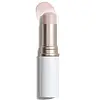What's inside
What's inside
 Key Ingredients
Key Ingredients

 Benefits
Benefits

 Concerns
Concerns

 Ingredients Side-by-side
Ingredients Side-by-side

Water
Skin ConditioningMethyl Trimethicone
Skin ConditioningDimethicone
EmollientCetyl Ethylhexanoate
EmollientIsononyl Isononanoate
EmollientAlcohol Denat.
AntimicrobialPolybutene
Polypropylsilsesquioxane
Butylene Glycol
HumectantGlycerin
HumectantPEG-10
HumectantPentylene Glycol
Skin ConditioningVinyl Dimethicone/Methicone Silsesquioxane Crosspolymer
CI 77891
Cosmetic Colorant1,2-Hexanediol
Skin ConditioningPrunus Serrulata Flower Extract
Skin ConditioningPanthenol
Skin ConditioningSodium Hyaluronate
HumectantChlorella Vulgaris Extract
Skin ConditioningTocopherol
AntioxidantAluminum Hydroxide
EmollientGlucose
HumectantPentaerythrityl Tetra-Di-T-Butyl Hydroxyhydrocinnamate
AntioxidantFructooligosaccharides
HumectantFructose
HumectantEthylhexylglycerin
Skin ConditioningCI 77007
Cosmetic ColorantTriethoxycaprylylsilane
Trisodium Ethylenediamine Disuccinate
Disteardimonium Hectorite
StabilisingMagnesium Sulfate
Bis-Diglyceryl Polyacyladipate-2
EmollientCetyl PEG/PPG-10/1 Dimethicone
EmulsifyingMica
Cosmetic ColorantCI 73360
Cosmetic ColorantCI 77491
Cosmetic ColorantCI 77492
Cosmetic ColorantWater, Methyl Trimethicone, Dimethicone, Cetyl Ethylhexanoate, Isononyl Isononanoate, Alcohol Denat., Polybutene, Polypropylsilsesquioxane, Butylene Glycol, Glycerin, PEG-10, Pentylene Glycol, Vinyl Dimethicone/Methicone Silsesquioxane Crosspolymer, CI 77891, 1,2-Hexanediol, Prunus Serrulata Flower Extract, Panthenol, Sodium Hyaluronate, Chlorella Vulgaris Extract, Tocopherol, Aluminum Hydroxide, Glucose, Pentaerythrityl Tetra-Di-T-Butyl Hydroxyhydrocinnamate, Fructooligosaccharides, Fructose, Ethylhexylglycerin, CI 77007, Triethoxycaprylylsilane, Trisodium Ethylenediamine Disuccinate, Disteardimonium Hectorite, Magnesium Sulfate, Bis-Diglyceryl Polyacyladipate-2, Cetyl PEG/PPG-10/1 Dimethicone, Mica, CI 73360, CI 77491, CI 77492
 Reviews
Reviews

Ingredients Explained
These ingredients are found in both products.
Ingredients higher up in an ingredient list are typically present in a larger amount.
Ci 77491 is also hydrated iron III oxide. It's sole purpose is to give a red/pink hue to products.
Iron III oxides are classified as inorganic chemicals for coloring.
Synthetically created Ci 77491 is considered safer than those naturally found. This is because the synthetically created version may contain less impurities. Iron oxides are generally non-toxic and non-allergenic.
Learn more about CI 77491Ci 77891 is a white pigment from Titanium dioxide. It is naturally found in minerals such as rutile and ilmenite.
It's main function is to add a white color to cosmetics. It can also be mixed with other colors to create different shades.
Ci 77891 is commonly found in sunscreens due to its ability to block UV rays.
Learn more about CI 77891Mica is a naturally occurring mineral used to add shimmer and color in cosmetics. It can also help improve the texture of a product or give it an opaque, white/silver color.
Serecite is the name for very fine but ragged grains of mica.
This ingredient is often coated with metal oxides like titanium dioxide. Trace amounts of heavy metals may be found in mica, but these metals are not harmful in our personal products.
Mica has been used since prehistoric times throughout the world. Ancient Egyptian, Indian, Greek, Roman, Aztec, and Chinese civilizations have used mica.
Learn more about MicaPentaerythrityl Tetra-Di-T-Butyl Hydroxyhydrocinnamate (long name, huh?) is a synthetic antioxidant.
It is used to help stabilize other antioxidants or prevent the color from changing in a product.
As an antioxidant, it helps fight free-radical molecules. Free-radical molecules are capable of damaging our cells and other genetic material. Thus, antioxidants may reduce the signs of aging.
This ingredient is oil-soluble.
Learn more about Pentaerythrityl Tetra-Di-T-Butyl HydroxyhydrocinnamatePolybutene is used to help control the viscosity of a product. This just means it helps adjusts the texture.
It is a polymer and does not get absorbed into the skin due to its large size.
Studies found this ingredient did not irritate skin in concentrations below 15%.
Learn more about Polybutene